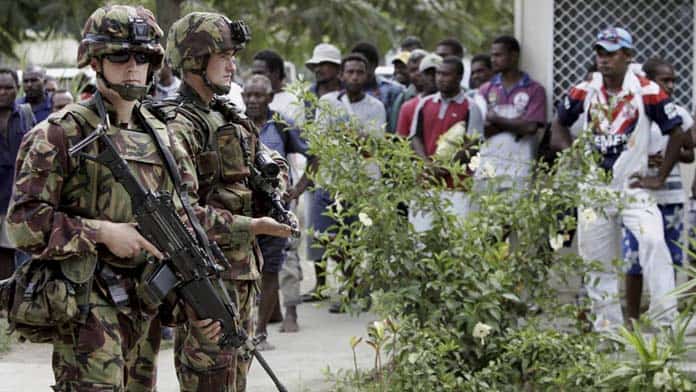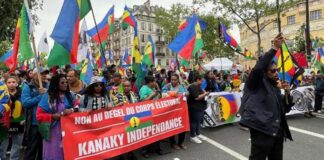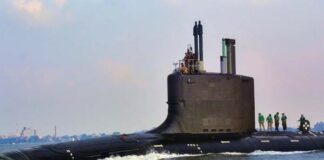The mainstream media has dutifully reported that “order” has been restored in the Solomon Islands (SI), following the arrival of Australian troops and police after protests and riots in late November.
But an additional offer from China of six police officers and riot gear, accepted by Solomon Islands Prime Minister Manasseh Sogavare in late December, was enough to spark alarm in Australian government circles.
China’s offer pales in comparison to the 200 troops and police sent from Australia, New Zealand and PNG.
However, Australia’s efforts, far from humanitarian, are specifically aimed at preventing rival powers from establishing a presence, in order to ensure long term strategic control and advance Australian imperialist interests.
In the 19th century Australia plundered the Solomons, kidnapping islanders to work as slaves through the “blackbirding” trade. Today it is not a source of significant profits for Australian companies.
But Australian capitalism still needs to ensure control of trade routes and the free passage of exports to Asia and the US, as well as access to military supplies. This is why the “stability” of the Solomons, Fiji, Vanuatu and other island groups in the region remains important to Australian governments—and why they oppose China’s involvement.
An earlier Australian military and police occupation, the Regional Assistance Mission to Solomon Islands (RAMSI), began in July 2003 and ended in August 2017.
Originally RAMSI was seen as a ten-year project to rebuild and strengthen the Solomon Islands’ state machine. Various Australian officials were placed in charge of the public service, courts and police.
This too was driven by strategic interests. In 2003, SI government officials told SBS TV that Indonesia had offered to send troops there, in two meetings in Bali and Canberra that year. This prompted then Prime Minister John Howard to act.
Ethnic divide
The RAMSI intervention was a response to the fracturing of the Solomons along regional lines, as it spiralled into armed conflict between rival militias after the Asian economic crisis of 1997.
Ethnic tensions erupted in 1998 on the main island of Guadalcanal, between locals and people from the island of Malaita, who have moved there in search of work over decades.
But the roots of the problems were economic. Capitalist development and export industries in timber, palm oil and fishing benefited only a small layer of the population, with many others living in poverty.
The recent riots are a product of the same Guale and Malaitan rivalry. Regional leaders on both sides are happy to fan divisions to advance their own positions.
For 36 years the Solomons recognised Taiwan instead of the mainland Chinese government in exchange for aid funding. But in 2019 Prime Minister Sogavare switched support to China in the hopes of a better deal.
This has become a focus for the regional divisions, with Malaita’s Provincial Premier Daniel Suidani condemning the shift. He is alleged to have fomented recent protests.
Defence think-tank the Australian Strategic Policy Institute has admitted, “The billions spent on RAMSI bought peace and stability for a time but did not solve the underlying problems that have festered in Solomon Islands since 1999.”
In fact Australia has made the problems worse, imposing neo-liberal policies focused on encouraging foreign investment. These plans have meant attacks on workers’ wages and conditions, as in June 2002, when the IMF and Australia pressured the government to implement public service cuts.
Tony Kagovai, President of the Solomon Islands’ National Union of Workers, said successive governments had been told, “You have to cut back the public service—teachers, nurses—in order that we give you money.”
In January 2004, public servants went on strike for a pay rise. RAMSI took “exception to” this and intervened to halt it. RAMSI said the country “could not afford” the pay rise and that “it threatened the country’s partnership with aid donors”—one of the biggest being Australia.
The recent riots saw anger diverted into ethnic divisions, as well as the looting and burning of Chinese-owned businesses. But working class action could provide an alternative focus and turn the anger against the Solomons’ corrupt political elite.
Workers have unionised on the waterfront, transport, the hospitals, schools and the public service.
Two public servants’ strikes planned in August and November 2009 were shut down by the government. In 2013, around 9000 teachers held three major strikes over pay. Nurses went on strike over COVID-19 allowance payments in October 2020, and Sogavare deregistered the nurses’ union in retaliation.
Much of the Solomons’ population is still based in an agricultural subsistence economy. But the organised working class has a social weight far larger than its numbers imply.
Australia military and police action operates to prop up the corrupt local elite.
It is workers and ordinary people in the Solomons whose struggles are the hope for change.
By Tom Orsag






